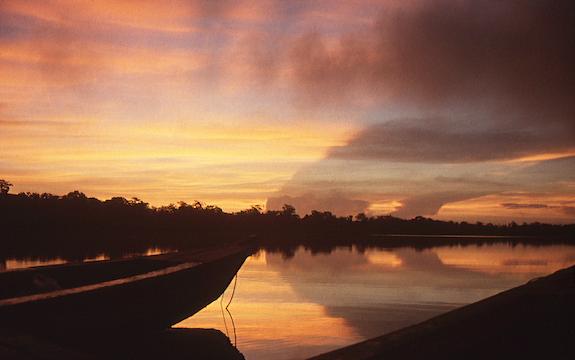Findings suggest that Maya settlement in city of Itzan started earlier and lasted longer than previously known

Credit: Andy Breckenridge
A McGill-led study has shown that the size of the Maya population in the lowland city of Itzan (in present-day Guatemala) varied over time in response to climate change. The findings, published recently in Quaternary Science Reviews, show that both droughts and very wet periods led to important population declines.
These results are based on using a relatively new technique involving looking at stanols (organic molecules found in human and animal faecal matter) taken from the bottom of a nearby lake. Measurements of stanols were used to estimate changes in population size and to examine how they align with information about climate variability and changes in vegetation drawn from other biological and archaeological sources.
By using the technique, the researchers were able to chart major Maya population changes in the area over a period starting 3,300 years before the present (BP). They were also able to identify shifts in settlement patterns that took place over the course of hundreds of years that are associated with changes in land use and agricultural practices.
They discovered, moreover, that the land had been settled earlier than previously suggested by archaeological evidence.
New tool provides surprising information about human presence in Maya lowlands
The evidence from faecal stanols suggests that humans were present on the Itzan escarpment about 650 years before the archaeological evidence confirms it. It also shows that that the Maya continued to occupy the area, albeit in smaller number, after the so-called “collapse” between 800-1000 AD, when it had previously been believed that drought or warfare caused the entire population to desert the area. There is further evidence of a large population spike around the same time as a historical record of refugees fleeing the Spanish attack of 1697 AD on the last Maya stronghold in the southern Maya lowlands (Nojpeten, or modern-day Flores in Guatemala) – something that had not been known before.
Estimates of ancient population size in the Maya lowlands have traditionally been obtained through ground inspection and excavation. To reconstruct population dynamics, archaeologists locate, map, and count residential structures, and they excavate them to establish dates of occupation. They compare population trends at the site and regional levels. And they then use techniques such as pollen analysis and indicators of soil erosion into lakes to reconstruct the ecological changes that took place at the same time.
“This research should help archaeologists by providing a new tool to look at changes that might not be seen in the archaeological evidence, because the evidence may never have existed or may have since been lost or destroyed,” said Benjamin Keenan, a PhD candidate in the Department of Earth and Planetary Sciences at McGill, and the first author on the paper. “The Maya lowlands are not very good for preserving buildings and other records of human life because of the tropical forest environment.”
Maya population size affected by both droughts and wet periods
The faecal stanol from the sediment in Laguna Itzan confirms that the Maya population in the area declined due to drought at three different periods; between 90-280 AD, between 730-900 AD and during the much less well studied drought between 1350-950 BC. The researchers also found that the population declined during a very wet period from 400–210 BC, something which has received little attention until now. The population decline in response to both dry and wet periods shows that there were climatic effects on population at both climate extremes, and not only during dry periods.
“It is important for society generally to know that there were civilisations before us that were affected by and adapted to climate change,” said Peter Douglas, an assistant professor in the Department of Earth and Planetary Sciences and the senior author on the paper. “By linking evidence for climate and population change we can begin to see a clear link between precipitation and the ability of these ancient cities to sustain their population.”
The research also suggests that the Maya people may have adapted to environmental issues such as soil degradation and nutrient loss by using techniques such as the application of human waste (also known as night soil) as a fertiliser for crops. This is suggested by a relatively low amount of fecal stanols in the lake sediment at a time when there is archaeological evidence for the highest human populations. One explanation for this is that human waste was applied to soils as fertilizer and therefore the stanols were not washed into the lake.
###
About this study
“Molecular evidence for human population change associated with climate events in the Maya lowlands” by Benjamin Keenan et al. was published in Quaternary Science Reviews. The research was funded by the Eric Mountjoy Fellowship, McGill startup funds, and an NSERC Discovery Grant.
DOI: https:/
About McGill University
Founded in Montreal, Quebec, in 1821, McGill University is Canada’s top ranked medical doctoral university. McGill is consistently ranked as one of the top universities, both nationally and internationally. It?is a world-renowned?institution of higher learning with research activities spanning two campuses, 11 faculties, 13 professional schools, 300 programs of study and over 40,000 students, including more than 10,200 graduate students. McGill attracts students from over 150 countries around the world, its 12,800 international students making up 31% of the student body. Over half of McGill students claim a first language other than English, including approximately 19% of our students who say French is their mother tongue.
https:/
Media Contact
Shirley Cardenas
[email protected]
Original Source
https:/
Related Journal Article
http://dx.




